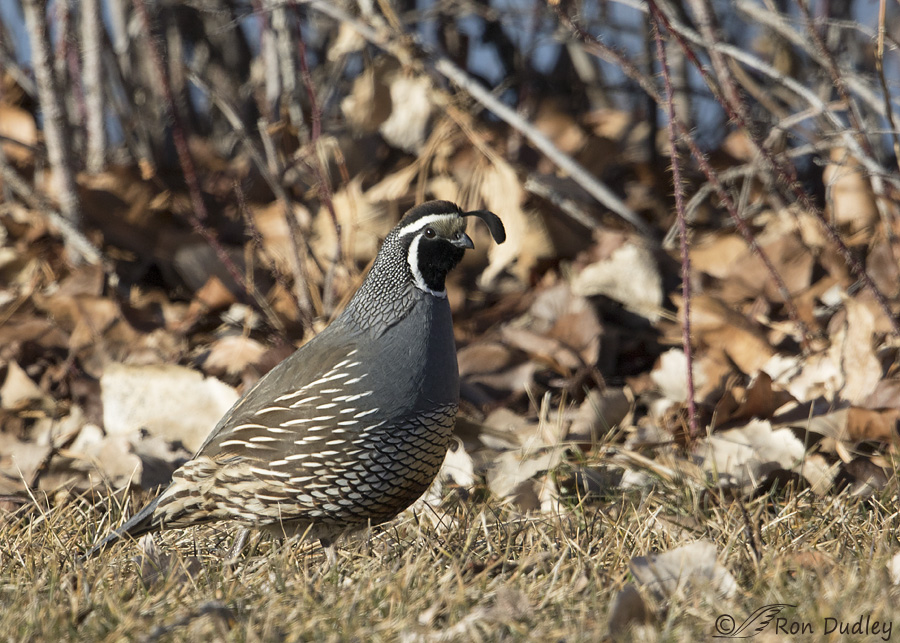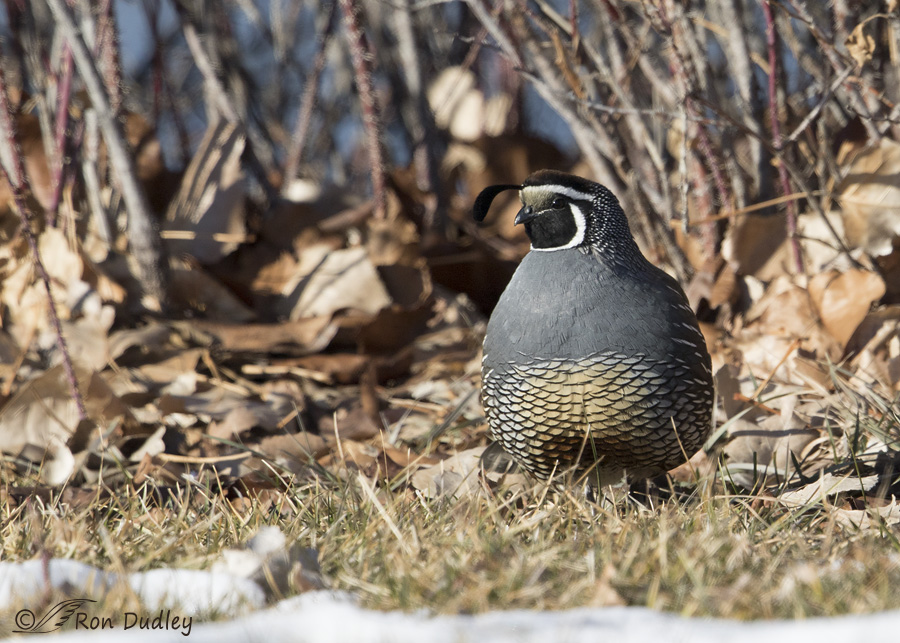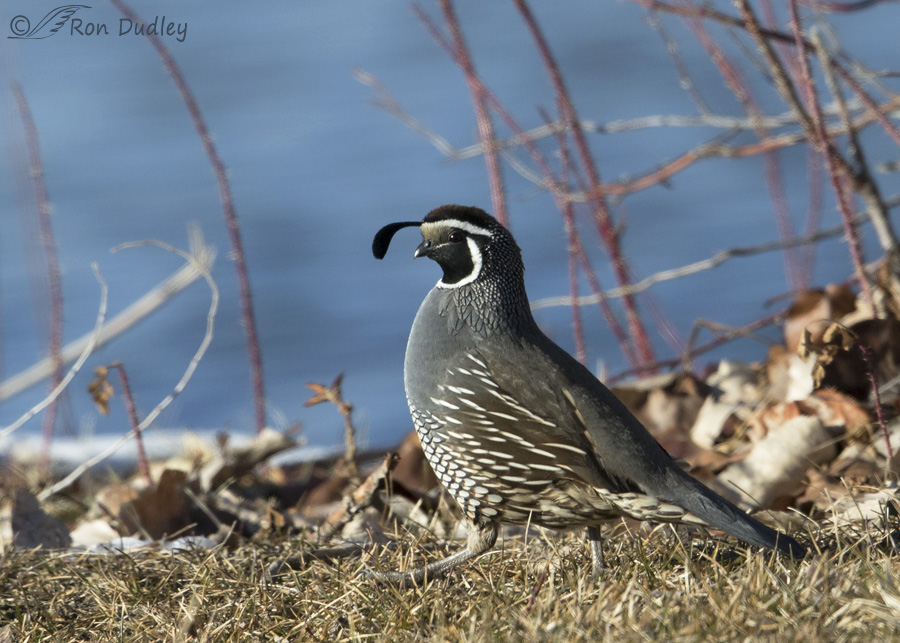Three days ago I found a covey of California Quail down by the Jordan River. I watched them forage for food for a while and then something interesting happened.
1/2500, f/6.3, ISO 500, Canon 7D Mark II, Canon EF 500mm f/4L IS II USM + EF 1.4 III Extender, not baited, set up or called in
Notice the blue of the pond behind the brush in the upper background. It’s a small pond lined with trees so when a large flock of Canada Geese decided to land on the pond they had to come in at a very steep angle and barely over the treetops. To the foraging quail the sudden appearance of the geese directly overhead must have seemed like a noisy (honking) squadron of attacking B-52’s because they panicked and dove into the brush for cover.
The first quail to reappear was this male. He was apparently their appointed sentry (typical behavior for quail) because he stood on this spot for over 10 minutes as the other quail slowly reemerged. And I mean he didn’t move for the entire time. I drove away to check out possible birds on the river and when I returned he was still there in the same position. I have no idea how long he played the frozen bird role because when I eventually left for home he still hadn’t twitched a feather or changed his foot position.
1/2000, f/6.3, ISO 500, Canon 7D Mark II, Canon EF 500mm f/4L IS II USM + EF 1.4 III Extender, not baited, set up or called in
Nearly all of my shots of these quail had cluttered settings but I thought I’d include this one for its good look at that scaled breast – perhaps the best field mark for distinguishing California Quail from the very similar Gambel’s Quail.
1/2500, f/6.3, ISO 500, Canon 7D Mark II, Canon EF 500mm f/4L IS II USM + EF 1.4 III Extender, not baited, set up or called in
I enjoy this last photo because of the water background (an unusual setting for the species in my experience), the running pose and the good look at the head plume or topknot. That topknot may look like a single feather but it’s actually a cluster of six overlapping feathers (black in males and dark brown in females). Sadly I wasn’t able to get any decent shots of females that day.
This was the first time I’ve seen quail in the vicinity of the river so you can bet I’ll be looking for them on future trips to the area.
Ron





I have never seen a Quail behave in that manner. That is interesting. I too hope you see them again. Beautiful birds, and I love your shots!
Even here in california I don’t see quail too often. I’ve only ever found them in one place, but in that place there were dozens of them. Mixed in with dozens of rabbits, all clustered together (a small game hunter’s paradise, huh?). I read that they’re usually found in places where flat, open, country joins up to thick, steep, country, and that’s exactly what that place is. A golf course surrounded by completely impenetrable brush. Sadly, because it’s a golf course, I’m not allowed to go there (I’ve been told off by the people there a couple times). It’s also a place where there are lots of things you can’t find other places (CA thrashers, spotted towhees, munias, bluebirds, and of course, the quail): all “locally common” birds around here.
Ron, sorry I am replying so late to your gorgeous photos of the California Quail. They are the best I have ever seen of that quail.
I have had the pleasure to live in Gambel’s Quail territory for many years and I have kept track of their behavior in my backyards. Today there were 3 pairs and it is not unusual for me to have 16-21 individuals to enjoy. At the present time the quail are in coveys and have already paired up but the 3 pairs are here most of the time!
BTW the male Gambel’s Quail has rufus colored feathers on the top back of their head, which makes them very colorful.
Sounds like you’re in quail heaven, Pat. Enjoy!
Beautiful series Ron!
Charlotte
Thanks, China.
Another really interesting post, Ron. I love that I always come away from your blog having learned something new! And yes, even a single Canada Goose can make quite a nuisance of himself. Poor quail!
Thanks, Marty – especially for the “learning” part…
Aside from the breast scaling, our Gambel’s (the males), have a very colorful head. Ours always take off in a flutter as if we were going to eat them. Haha Very camera shy!
Linda, I believe the small scaling on the back of the neck is also unique to the California.
Poor guy! Frozen sentry that he was! Can only imagine how terrifying that must have been…only a few Canada geese can make a LOT of racket and noise. Beautiful shots of the bird…didn’t know that topnot was made of several feathers not just one big one
The only times I ‘ve seen these quails was far from water and in pretty dry areas….love the babies!
Patty, it sure looks like a single feather, even up close.
I live in Sugarhouse and my neighbor and I have had them nesting often in the flower beds. They also clean up under the bird feeder. I love to watch them specially the chicks.
Betty, The chicks are a blast. They sometimes nest under my shed next to the garden.
I just love quail! Living in Ogden though I notice the lack of snow.. We are buried! Thanks for the photos!
We still have some snow, Leah but not nearly as much as you do.
Gorgeous shots! Love the memories of seeing this species, just simply a beautiful bird.
I like all three shots, shows the plumage well and the catch light is in each shot!
Thank you, Dick.
California Quail do look a lot like the Gambel’s Quail, which is what we have here. I’m not sure I’ve observed the Gambel’s Quail closely, even though on one occasion we had one on the back wall of our property. It’s good to know the difference between the two species. I did not know that the California Quail could be found outside California…
Susan, California Quail are found all along the west coast from Baja clear up to British Columbia, then inland to some areas of the Intermountain West including much of western Idaho and northern Utah.
Beautiful! You really captured the detail of the bird. 🙂 Thx for the “story” to go with it. Imagine the incoming geese were REALLY terrifying for them.
Those geese got my attention too, Judy. Amazing how big they are when they’re directly overhead. Just the wing noise alone was loud, then throw in all the honking…
Beautiful shot5s of beautiful birds. Being an Easterner, thank you for the birding ID lesson.
Thanks, Richard. That’s one of the reasons I posted these images – this species has a pretty limited range out west and most folks don’t get to see them.